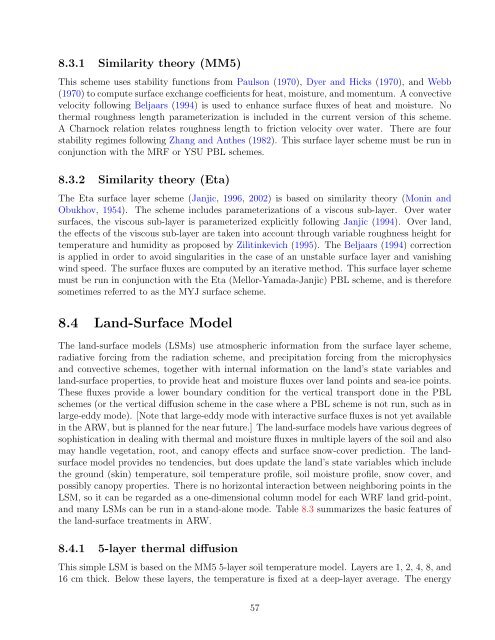Advanced Research WRF (ARW) Technical Note - MMM - University ...
Advanced Research WRF (ARW) Technical Note - MMM - University ...
Advanced Research WRF (ARW) Technical Note - MMM - University ...
Create successful ePaper yourself
Turn your PDF publications into a flip-book with our unique Google optimized e-Paper software.
8.3.1 Similarity theory (MM5)<br />
This scheme uses stability functions from Paulson (1970), Dyer and Hicks (1970), and Webb<br />
(1970) to compute surface exchange coefficients for heat, moisture, and momentum. A convective<br />
velocity following Beljaars (1994) is used to enhance surface fluxes of heat and moisture. No<br />
thermal roughness length parameterization is included in the current version of this scheme.<br />
A Charnock relation relates roughness length to friction velocity over water. There are four<br />
stability regimes following Zhang and Anthes (1982). This surface layer scheme must be run in<br />
conjunction with the MRF or YSU PBL schemes.<br />
8.3.2 Similarity theory (Eta)<br />
The Eta surface layer scheme (Janjic, 1996, 2002) is based on similarity theory (Monin and<br />
Obukhov, 1954). The scheme includes parameterizations of a viscous sub-layer. Over water<br />
surfaces, the viscous sub-layer is parameterized explicitly following Janjic (1994). Over land,<br />
the effects of the viscous sub-layer are taken into account through variable roughness height for<br />
temperature and humidity as proposed by Zilitinkevich (1995). The Beljaars (1994) correction<br />
is applied in order to avoid singularities in the case of an unstable surface layer and vanishing<br />
wind speed. The surface fluxes are computed by an iterative method. This surface layer scheme<br />
must be run in conjunction with the Eta (Mellor-Yamada-Janjic) PBL scheme, and is therefore<br />
sometimes referred to as the MYJ surface scheme.<br />
8.4 Land-Surface Model<br />
The land-surface models (LSMs) use atmospheric information from the surface layer scheme,<br />
radiative forcing from the radiation scheme, and precipitation forcing from the microphysics<br />
and convective schemes, together with internal information on the land’s state variables and<br />
land-surface properties, to provide heat and moisture fluxes over land points and sea-ice points.<br />
These fluxes provide a lower boundary condition for the vertical transport done in the PBL<br />
schemes (or the vertical diffusion scheme in the case where a PBL scheme is not run, such as in<br />
large-eddy mode). [<strong>Note</strong> that large-eddy mode with interactive surface fluxes is not yet available<br />
in the <strong>ARW</strong>, but is planned for the near future.] The land-surface models have various degrees of<br />
sophistication in dealing with thermal and moisture fluxes in multiple layers of the soil and also<br />
may handle vegetation, root, and canopy effects and surface snow-cover prediction. The landsurface<br />
model provides no tendencies, but does update the land’s state variables which include<br />
the ground (skin) temperature, soil temperature profile, soil moisture profile, snow cover, and<br />
possibly canopy properties. There is no horizontal interaction between neighboring points in the<br />
LSM, so it can be regarded as a one-dimensional column model for each <strong>WRF</strong> land grid-point,<br />
and many LSMs can be run in a stand-alone mode. Table 8.3 summarizes the basic features of<br />
the land-surface treatments in <strong>ARW</strong>.<br />
8.4.1 5-layer thermal diffusion<br />
This simple LSM is based on the MM5 5-layer soil temperature model. Layers are 1, 2, 4, 8, and<br />
16 cm thick. Below these layers, the temperature is fixed at a deep-layer average. The energy<br />
57
















